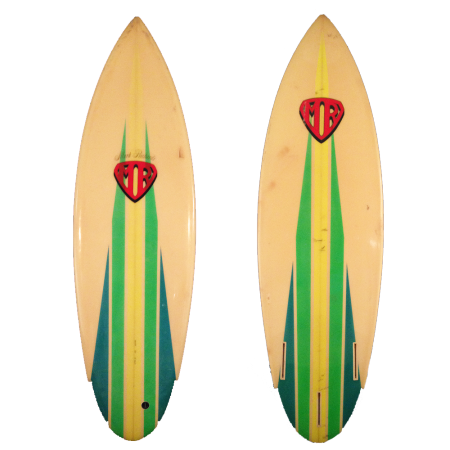
Amidst the noise and chaos of The Boardroom show, I strained to listen while Donald Brink unpacked the theory behind asymmetric surfboard design. His booth was packed with a wide array of wave riding crafts; stringerless EPS longboards, reversible Paipo boards, hulls, spoons, nearly all of which had a different distribution of foam on the left hemisphere than the right hemisphere.
Donald pointed to an anatomical rendering of the human foot and explained how the pivot point is not centered, therefore there is no need for the foam distribution in a surfboard to be centered. ”Under one’s ankle is where that central reference line should be,” Donald elaborated.
All of my thoughts could be summed up with the answer to one simple question. “Is that to say that you believe all board designs could be improved upon with asymmetrical adjustments?” I asked.
“I believe so,” Donald answered confidently. The next week, I showed up to Donald’s shaping room with a reference board and a challenge: to shape a new board with asymmetrical adjustments based off an old favorite.
THE REFERENCE BOARD: 5’9″ Mark Richards Rounded Tail Tri-Fin
“This would have been built in the late 70’s/ early 80’s. Robin Prodonavitch was the original shaper of all the models at G&S. If he was ‘snowed under’ they used Ernie Duck, so he shaped this one. Prior to the machine days they were done from my outline and rocker templates.” – Mark Richards
“The MR Tri-Fin is a beautiful board and very iconic to its original era’s movement,” Donald says. “The board is fairly simple in its design principal and yet has a few subtle details incorporated in it that were shaped and glassed with true craftsmanship. The panel Vee throughout is the boldest element and it’s followed strongly with plenty of volume in the entire shape. It has a flat deck and full down rails from nose to tail.” The board is built well. Donald plans on referencing the volume and accuracy of the arc to keep the same flavor of the board, but make a few subtle adjustments to make it more accommodating to everyday surfing conditions.
AN OVERVIEW OF ASYMMETRICAL DESIGN THEORY, ACCORDING TO DONALD:
There are limitations encountered with backside surfing because of the pivotal position of one’s ankle and differing leverage available in the foot between the toes and the heel. The asymmetric improvements are designed to accommodate the heavier weight that is distributed through the heel and allow for the leveraging ability of the toes.
The goal is to be more sensitive on the toes and more forgiving on the heels.
Asymmetrical changes are made to a specific stance, in this case the surfer is regular footed. I’ll apply more curve on the toe-side rail in the plan shape and maintain a straighter heel-side rail line. Closer fin placement on the heel-side, complimented with bottom contours and angles assist in creating optimal drive and water flow.
As for the rail thickness flow, the toe-side rail will be thinner and more “down” to provide sensitivity (and accommodate the leveraging ability of the toes). The heel-side rail will be thicker and the apex higher to add forgiveness and allow for the heavier weight setting of the heels.
Additionally, to promote sensitivity within this full-volume, grovel-style board, I’ve designed the tail area thinner to get the feet both closer to the fins and the water whilst maintaining the flat deck for volume and its constant linear reference for the front foot.
Keep in mind that no design principle exists in isolation. Each of these principles are designed in concert with one another to enhance each other and increase water flow.
THE CENTRAL REFERENCE LINE
According to Donald, the center of your foot is not where your foot pivots. Your ankles are the pivot points and they are closer to your heels and leverage occurs in front of the ankles, with the toes. While surfing, how you transition from one rail to another is an extension of your ankle’s movements. So the design goal of the offset center is a reflection of one’s foot orientation and pivotal positioning.
Taking the stringer out throws a whole new twist in things. Literally. “When using stringerless EPS, boards not only flex, but they also twist,” he says. “Bisecting the plane of torsion with a stringer limits the board’s ability to twist. Small, thick boards like this one are strong enough without a stringer and the absence on that rigidity keeps the board lively and light.”
Donald keeps things close to the original board. While the toe-side rail line in his design is very similar to the MR Tri-Fin, the heel-side rail is longer and straighter. “Generally,” he explains, “if you eliminate the real estate behind one’s back heel, the board will come around on a heel turn arc more quickly. The straighter rail line also compliments the fuller (thicker) rail and allows you to access speed more easily with less maneuvering. Again, all of these designs are a reflection of the anatomy of the heel, its added weight and limited ability to leverage.”
THE FINAL SURFBOARD
5’9″ Asymmetric, Rounded Tail, Tri-Fin by Donald Brink
Donald Brink has an interesting take on shaping. When it comes to referencing a board that’s already been ridden, his main goal is to help the surfer get exactly what they want. “I really enjoy referencing a board that somebody has,” he says. “It’s not to copy the ideas but rather to create a foundation for the sensations described by the rider. Every person has their own interpretation of a ride and the sensations experienced.” My job is to capture the adjectives someone uses to describe their experience and try to expand upon them with this updated design.”
Visit Donald’s website at DonaldBrink.com



